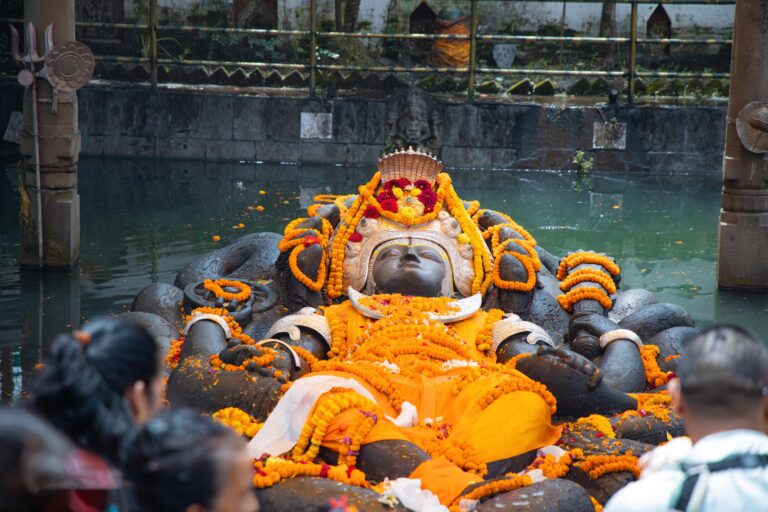Kathmandu: Budhanilakantha Municipality has taken a significant step toward securing UNESCO World Heritage status for the revered Budhanilakantha Temple. The historic temple, home to the iconic reclining statue of Lord Vishnu, is a cornerstone of Nepal’s rich cultural and religious heritage. Recognizing its historical and architectural value, local authorities have initiated discussions to support its inclusion in the prestigious list.
Why Budhanilakantha Temple Deserves UNESCO Recognition
The Budhanilakantha Temple, located at the foothills of the Shivapuri National Park, is renowned for its massive stone-carved statue of Lord Vishnu resting on a bed of serpents. Believed to have been sculpted during the reign of Vishnu Gupta in the second century, the temple is not only an important religious site but also a masterpiece of Nepalese art and craftsmanship.
The temple attracts thousands of devotees and tourists annually, yet it remains underrepresented on the global heritage stage. Local historians and cultural experts emphasize that recognition from UNESCO would ensure greater preservation efforts and global awareness of its significance.
The Path to UNESCO Inclusion
Discussions involving government officials, historians, cultural experts, intellectuals, writers, and journalists have been set in motion. The initiative aims to compile historical evidence, architectural documentation, and environmental studies to bolster the temple’s nomination.
During a recent forum, prominent figures, including Professor Dinesh Raj Pant, theologian Dr. Govinda Tandan, Nepal Bhasa Academy Chancellor Malla K Sundar, and Nepal Academy of Fine Arts Chancellor Narad Mani Hartamchhali, stressed the need for a well-documented proposal. Writers Sneha Sayami, Shyam Rimal, and Shreesh Bhandari also contributed insights, urging local authorities to showcase the temple’s architectural uniqueness and cultural depth.
To enhance the temple’s chances, experts recommend conducting an extensive study of the natural and historical environment surrounding the Shivapuri-Budhanilakantha region. This research would support claims that the site meets UNESCO’s criteria for cultural and historical significance.
Historical and Religious Importance
Budhanilakantha Temple is a revered pilgrimage site in Nepalese Hindu tradition. According to legend, the colossal statue was discovered in a field and has remained a mystery regarding its exact origins. The temple is also known for its unique prohibition: Nepalese monarchs are traditionally forbidden from visiting, based on an ancient prophecy warning of misfortune should they do so.
This temple serves as a focal point for several Hindu festivals, particularly Haribodhini Ekadashi, when thousands of devotees gather to pay homage to Lord Vishnu. The temple’s religious and historical narratives, coupled with its architectural marvel, make it a prime candidate for global recognition.
Potential Benefits of UNESCO Status
Securing a UNESCO World Heritage designation would offer multiple benefits, including:
- Preservation Funding: Increased access to financial and technical support for conservation efforts.
- Tourism Boost: Greater global exposure leading to increased international tourism and economic growth in the region.
- Cultural Recognition: Acknowledgment of Nepal’s contributions to global heritage and cultural history.
- Infrastructure Development: Potential improvements in local infrastructure and amenities for visitors.
Challenges and the Road Ahead
While the effort is promising, the journey to UNESCO recognition is complex and requires meticulous documentation, governmental coordination, and strong advocacy. The Nepalese government, in collaboration with Budhanilakantha Municipality, must ensure a well-researched nomination dossier that highlights the temple’s historical and cultural significance.
Experts also highlight the importance of local and international community involvement. Engaging heritage conservation organizations, religious scholars, and local communities will strengthen the application. Additionally, securing heritage-friendly policies from the Nepalese government will be crucial for long-term preservation and management.
The initiative to include Budhanilakantha Temple in the UNESCO World Heritage List is a landmark effort in preserving Nepal’s cultural and religious identity. By leveraging historical research, environmental studies, and expert recommendations, the municipality aims to elevate the temple’s global standing.
For more updates on Nepal’s cultural heritage and ongoing developments, visit Nepal Monitor.


